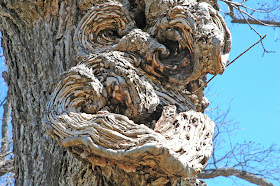It is amazing what a couple of warm nights will do to advance bud development in pecan trees. The twigs, pictured at left, show the first stages of spring bud development. The upper bud on the far-left twig is in the bud swell stage. Here the normally narrow dormant bud has ballooned into a large plump bud. Moving down the same twig, you'll see a bud in the a stage we call
outer scale split. The brownish scale covering the bud has split open revealing a silvery inner bud.
As sunlight hits the silvery bud and it continues to expand in length, the bud will begin to green up (right hand twig in photo at left). On mature trees, you will note that the inner bud is actually made up of three buds--the two smaller buds surrounding a larger central bud. The buds on the outside will develop into catkins while the central bud will become a new shoot that will eventually terminate in a pistillate flower cluster.

Vegetative shoots on young trees produce buds that contain only a single vegetative inner bud.
The next stage in bud development is called
inner scale split (photo at right). As green buds continues to enlarge, the inner scale splits open to reveal either catkins or a new shoot. At this point, the emerging plant structures are still compressed but you can easily recognize what they will become.
As pecan buds continue to grow you be able to distinguish between protandrous
and protogynous
cultivars.
Protandrous cultivars release pollen early in the pollination season and before their pistillate flowers become receptive.
Protogynous cultivars shed their pollen late in the pollination season while producing receptive female flowers early, before they shed their pollen.
In the photo below, the twig on the left has well defined catkins emerging while the vegetative buds have just begun leaf burst. This twig was cut from a Pawnee tree, a protandrous cultivar. The twig below and to the right was cut from the protogynous cultivar, Kanza. Notice that the two buds on either side of the enlarged, central vegetative bud are still relatively small. Kanza catkins will develop later, well after new leaves start emerging. Look closely at the Kanza vegetative bud (large bud at the top) and you will see that the inner scale has split.
Following bud break is important for two reasons. First, the pecan tree grafting season begins when the buds enter the inner scale split stage. And second, control measures for pecan phylloxera are timed to specific bud development stages. Insecticide treatment for pecan stem phylloxera should be applied just before innner scale split. Pecan leaf phylloxera sprays should be timed at leaf burst (first leaf unfolds).
 It is important to remember that the number of catkins produced by a tree is not an indication of the size of this year's nut crop. It is the number of pistillate flowers produced on a tree that determines potential yield. A full crop occurs when at least 65% of new shoots produce pistillate flowers.
It is important to remember that the number of catkins produced by a tree is not an indication of the size of this year's nut crop. It is the number of pistillate flowers produced on a tree that determines potential yield. A full crop occurs when at least 65% of new shoots produce pistillate flowers.





















